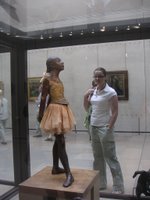From Railway Stations to Palaces
On one of our final days in Paris, we also visited one of my favorite sites, the Musée D'Orsay. I'm obviously not the only one who loves this museum; when we arrived, just minutes after it opened for the day, the line already contained hundreds of would-be patrons. Luckily, we were armed with our Museum Cards, which allowed us to use an alternate, line-free entrance. Although I'd visited the museum several times before, I still found myself happily gawking at the paintings, sculptures, and objects. It's a much more manageable size than the Louvre and it includes work from a more condensed timeline. As the museum's website explains, "The Musée d'Orsay is a national museum which opened to the public in December 1986 in order to show, in all its diversity, the artistic creation of the western world from 1848 to 1914." I also bought a book for my niece on the museum called "My Little Orsay." There was a similar book about the Louvre, but I felt like it would be easier for her to connect with images from the D'Orsay, including works like Francois Pompon's "Polar Bear in Stride", and Degas' "Dancer."


As with our trip to the Louvre, Aviva found herself frequently thinking about her art history classes as we wandered through the museum, particularly when we overheard teachers speaking to their students about the importance of Manet's controversial Déjeuner sur l'herbe or Renoir's Bal au Moulin de la Galette. I had to stop and puzzle over Gustave Corbet's L'Origine du monde as I've often wondered why a man who spent so much of his life painting pastoral scenes of stags fighting and the beaches of Normandy suddenly created this risqué work. Like so many of the artists represented at this museum, he was a real trouble maker! I also made Aviva stand for the token D'Orsay shot: standing in front of one of the station clocks with the Louvre in the background.





On our final day in the city, we visited the Château de Versailles, but not before we bundled up and packed a lunch for what proved to be a long and blustery day. Before taking our lengthy metro ride to Versailles, we stopped at a pastry shop near our hotel to order sandwiches for our lunch as a visit to the palace years ago had taught me that it's best to bring food along. The only food you'll find on site is extremely expensive and not terribly appealing.
The palace was georgeous, though we were a bit frustrated by the constant extra fees you must pay too see the entire site. Even though our museum card was supposed to get us into all areas of the museum, they charged us several times to pass through areas that stood between one building and another.
For example, there was an exhibit known as The Grandes Eaux Musicaux taking place in the gardens just outside the palace; however, you couldn't pass through the garden to get to the Petit Trianon, where you'll find Marie Antoinette's hamlet, and the Grand Trianon, both of which were included in our ticket price, without paying the admission fee for the Grandes Eaux spectacle. A scam, I tell you! Oh well. We decided to suck it up and pay the additional fee. While entering the Grandes Eaux cost us another 10 odd Euros each, it really was quite lovely. As you walk throughout the gardens, baroque music played in time to the grand fountains of the palace. And it would have been ridiculous to miss out on the palace gardens and Marie's fascinating "little" playground, where she liked to pretend she was a milkmaid. Below, you will see Aviva's best Marie Antoinette impersonation.


The palace was georgeous, though we were a bit frustrated by the constant extra fees you must pay too see the entire site. Even though our museum card was supposed to get us into all areas of the museum, they charged us several times to pass through areas that stood between one building and another.
For example, there was an exhibit known as The Grandes Eaux Musicaux taking place in the gardens just outside the palace; however, you couldn't pass through the garden to get to the Petit Trianon, where you'll find Marie Antoinette's hamlet, and the Grand Trianon, both of which were included in our ticket price, without paying the admission fee for the Grandes Eaux spectacle. A scam, I tell you! Oh well. We decided to suck it up and pay the additional fee. While entering the Grandes Eaux cost us another 10 odd Euros each, it really was quite lovely. As you walk throughout the gardens, baroque music played in time to the grand fountains of the palace. And it would have been ridiculous to miss out on the palace gardens and Marie's fascinating "little" playground, where she liked to pretend she was a milkmaid. Below, you will see Aviva's best Marie Antoinette impersonation.


At least they didn't force us to fork over the money for a carriage ride, which cost several hundred Euros.





0 Comments:
Post a Comment
<< Home